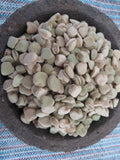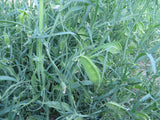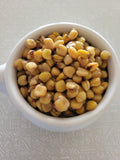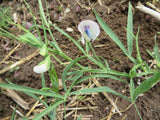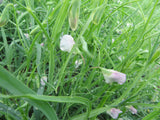Quick facts
- Frost tolerant bean
- Soil improving crop, not to be eaten regularly (see below)
- Lovely flowers
Lathyrus sativus
We originally obtained this crop from the Experimental Farm Network and we loved growing it. We loved it's pretty leaves, flowers, and sprawling shape. As a nitrogen fixer, it's an excellent crop to improve soil as it brings nitrogen into the soil while requiring little in the way of fertility and water. The beans can be eaten, but must not be eaten every day. Please see what the Experimental Farm Network writes below:
"In central Italy, especially Umbria and Tuscany, it is a regional delicacy (in the "Cucina Povera" — poverty food — tradition) known as cicerchie, which is usually translated as "wild chickpea." In parts of Spain, especially La Mancha, it is known as almorta, and it is often made into gruel-like soup eaten with bread. However, it is actually illegal in Spain to sell it as food for human consumption due to a curious — but very important — characteristic of this species.
The seeds contain a neurotoxic amino acid known as oxalyldiaminopropionic acid (usually shortened to ODAP). Eaten sporadically as just one of many protein sources, it has never been known to cause a problem. But when people eat grass pea as their only protein source over many months, it can cause a neurodegenerative condition known as "lathyrism" (named after this species) which can result in paralysis of the lower body. There are historic records of lathyrism outbreaks following extended famines in areas where grass pea is grown. From a farmer's perspective, this is a wonderful crop — easy to grow, hard to kill, and nitrogen fixing — so it has long been planted as an "insurance crop." Because it can survive prolonged droughts that kill everything else, during a drought-induced famine, it is often the only food around.
There are breeders out there working to develop grass peas with low or no ODAP, because it is a food so many people love — and it also offers nutritional benefits beyond protein and fiber: it's one of the only dietary sources of L-homoarginine, a non-essential amino acid currently under intense study as a cardio-protective agent (based on a study that found low levels of L-homoarginine in the blood correlates with higher risk for heart problems). This is certainly not an everyday food, but for its resilience, soil improving ability, and taste — not to mention the beauty of its blue flowers — it is well worth having around." Experimental Farm Network
How to grow it:
|
Germ Temp |
Indoor Start |
Germ Days |
Frost Tolerant |
Sun |
Seed Depth |
Plant/Row Spacing |
|
60-85 |
2 weeks |
6-17 d. |
Yes |
Full |
1-1.5” |
3-6”/8-10” |
Plant in early spring when you plant peas. If you choose to, you can start them in the greenhouse and transplant very carefully. Plants are frost tolerant and you can treat them as you would peas, garbanzos, lentils, or any other frost tolerant bean. Thrives in cooler weather, so get these started early. Plants and ferny and a little sprawly, but when planted densely they help support each other.
Seed specs: Packet size- 30 seeds min.





